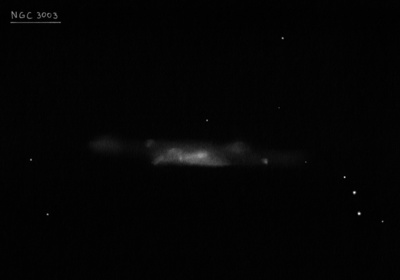
William Herschel discovered NGC 3003 = H V-26 = h639 on 7 Dec 1785 (sweep 487) and recorded "cB, mE nearly in the parallel, 8' long, 3' broad." His position is accurate. John Herschel described this object on 22 Jan 1828 (sweep 51) as "a singular curved wisp of nebula, It curls up and tapers off at the s p side, and is clubbed at the n f extremity."
A total of 13 observations were made at Birr Castle. On 8 Mar 1858, R.J. Mitchell commented "of unequal brightness throughout its length, p part is F but contains a B patch with a star in it; the foll part is comparatively much brighter and is mottled."
300/350mm - 13.1" (3/3/84): moderately bright, very elongated 7:2 WSW-ENE, 3.5'x1.0', almost even surface brightness.
600/800mm - 24" (4/20/14): bright, large, very elongated 4:1 WSW-ENE, 4.0'x1.0', mottled appearance, slightly bulging brighter core and nucleus, brighter and patchy along the major axis with a couple of very small knots. Nearly detached at the west end is a very low surface brightness patch that seems angled or extends beyond the major axis. A mag 15.7 star is ~1' N of center. NGC 3003 and NGC 3021, located 30' ENE, are the two brightest members in the USGC U268 group (z ~.005).
Notes by Steve Gottlieb